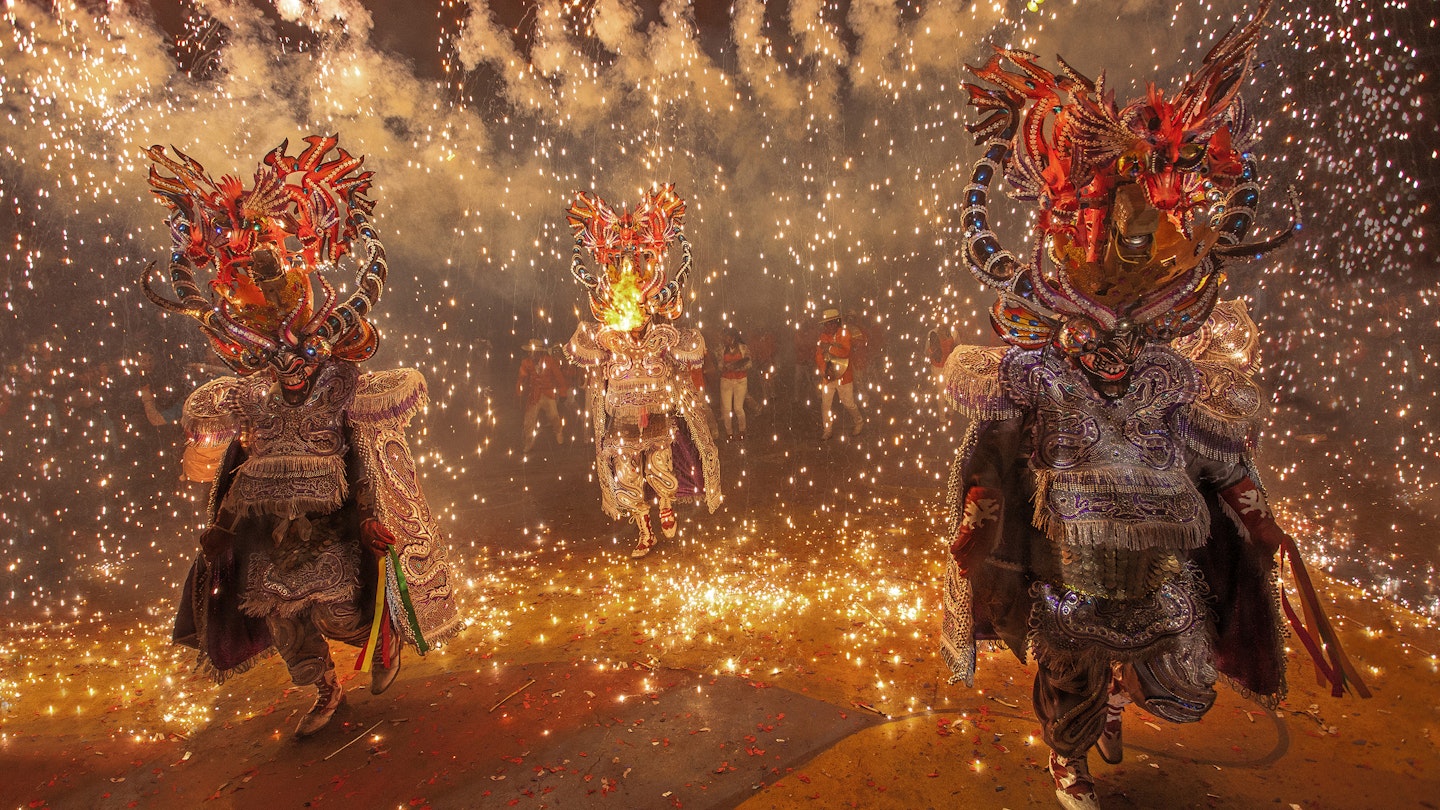Carnival Celebrations Across Latin America
Rio isn’t the only city that knows how to celebrate Carnival in style. In the week leading up to Lent, millions of people across Latin America take to the streets for dancing, live music, drinking, and revelry—along with a range of unusual and surprising traditions.
In Paraty, Brazil, participants cover their bodies in mud; in Trinidad and Tobago, they smear themselves with melted chocolate. In Paraguay, Carnival-goers spray each other with fake snow. In Panama, water trucks cool down the crowds. And in Mexico, the party kicks off with the burning of a giant papier-mâché effigy.
Burning of the Bad Mood (Quema del Mal Humor) – Mexico
In Mexico, Carnival kicks off with a beloved tradition: the Quema del Mal Humor, or Burning of the Bad Mood. The ritual begins with a larger-than-life effigy of a disliked political figure or celebrity—picture a huge, cartoonish piñata—suspended over the crowds. Then the papier-mâché puppet is set on fire, and carnival-goers cheer and celebrate as it goes up in flames. The tradition is symbolic: as the piñata burns, it signals people to let go of their everyday worries and enjoy the start of the festivities.
The Burning of the Bad Mood happens at Carnival celebrations all over Mexico, notably in Veracruz and Mazatlan, with celebrations seeing diverse figures burned, including effigies of ex-president Enrique Peña in 2019.
Mud Block (Bloco da Lama) – Brazil
More than 100 miles away from the flashing lights of Rio’s Sambadrome, there’s a lesser-known celebration in the historic city of Paraty—one that’s more down-to-earth. Instead of feathered headdresses and sequined wings, many Carnival-goers wear mud.
The Bloco da Lama has humble origins: during carnival in 1986, after a tropical rain shower, a group of teenagers started playing with mud on the beach, and then paraded through the streets, unrecognizable to their own friends and family.
Every year, festival-goers wade into pools of mud, smearing it on their bodies and faces, throwing it, wrestling in it, and then dancing to live samba and reggaeton as part of the larger carnival celebration. It’s a one-of-a-kind spectacle that’s practically the polar opposite of the glitter and neon lights of Rio’s Carnival, yet just as much fun.
Snow Celebrations – Paraguay
It almost never snows in the balmy city of Encarnación, Paraguay. This may explain the novelty of the faux snow spray cans that are integral to local carnival celebrations. Be forewarned: if you’re joining this street party, you may be sprayed in the face with “snow,” doused with shaving cream, or get your clothes stained with white paint.
The illusion of winter weather in summertime is part of the fantasy in Encarnación, the self-proclaimed “Carnival Capital of Paraguay.” It’s a title the city deserves, hosting one of the region’s liveliest celebrations—with a permanent Sambadrome that accommodates up to 12,000 revelers.
Carnival de Oruro – Bolivia
The Carnival of Oruro, Bolivia, enjoys special distinction: Unesco named it a Masterpiece of the Oral and Intangible Heritage of Humanity. These annual celebrations have deep indigenous roots and a history dating back to ancient times, when the area was a major religious center. Spanish colonists outlawed native ceremonies, which led to an introduction of Catholic traditions.
During Oruro’s Carnival, the colors and sounds are in full force during the Diablada (The Dance of the Devils), a ritualistic dance starring hundreds of devils in decorative costumes, grotesque masks, and flowing wigs. It’s the battle between good and evil, featuring devils and angels, alongside dancers representing the seven deadly sins: pride, greed, lust, anger, gluttony, envy, and sloth.
La Mojadera – Panama
It gets hot and sweaty in the streets during Carnival celebrations in Las Tablas, Panama. Local crowds are prepared for the tropical weather. Every year, culecos (water trucks) park in the plazas and slowly drive through the streets, spraying festival-goers with water as they dance, sing, and drink copious amounts of cerveza.
When the party’s in full swing, it’s nearly impossible to avoid la mojadera (water spray), which can sprinkle or drench you completely. Carnival participants come armed with water guns and balloons, creating an environment ripe for hilariously entertaining water fights. Be prepared for cold water surprises; locals might even dump buckets of cold water directly over your head!
J’Ouvert – Trinidad and Tobago
In Port of Spain, Trinidad and Tobago, Carnival begins at dawn. J’Ouvert (derived from the creole French term jou ouvère, meaning “daybreak”) is the raucous celebration that officially starts the festivities. The streets overflow with people dancing and celebrating, but unlike in Rio and other famous carnival destinations, participants wear old clothes and cover themselves in chocolate, oil, paint, or mud.
This tradition references the past, as enslaved people weren’t included in the plantation owners’ parties. They’d use whatever materials they could find to disguise themselves, ensuring they wouldn’t be recognized in the street party. Today, it’s a powerful way to blur racial and ethnic lines, making Carnival an inclusive celebration that welcomes all. The more, the merrier!





